女权主义 Gender in Translation A Study on Feminist Translation in Bing Xin’s Translation Works
- 格式:ppt
- 大小:1.44 MB
- 文档页数:8
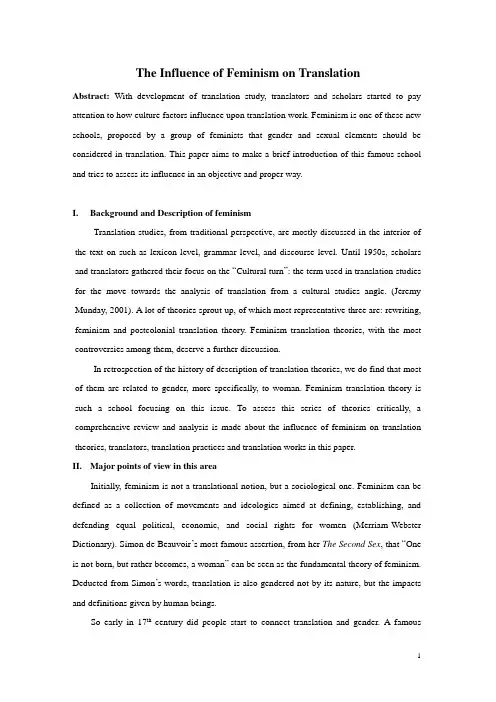
The Influence of Feminism on TranslationAbstract: With development of translation study, translators and scholars started to pay attention to how culture factors influence upon translation work. Feminism is one of these new schools, proposed by a group of feminists that gender and sexual elements should be considered in translation. This paper aims to make a brief introduction of this famous school and tries to assess its influence in an objective and proper way.I.Background and Description of feminismTranslation studies, from traditional perspective, are mostly discussed in the interior of the text on such as lexicon level, grammar level, and discourse level. Until 1950s, scholars and translators gathered their focus on the “Cultural turn”: the term used in translation studies for the move towards the analysis of translation from a cultural studies angle. (Jeremy Munday, 2001). A lot of theories sprout up, of which most representative three are: rewriting, feminism and postcolonial translation theory. Feminism translation theories, with the most controversies among them, deserve a further discussion.In retrospection of the history of description of translation theories, we do find that most of them are related to gender, more specifically, to woman. Feminism translation theory is such a school focusing on this issue. To assess this series of theories critically, a comprehensive review and analysis is made about the influence of feminism on translation theories, translators, translation practices and translation works in this paper.II.Major points of view in this areaInitially, feminism is not a translational notion, but a sociological one. Feminism can be defined as a collection of movements and ideologies aimed at defining, establishing, and defending equal political, economic, and social rights for women (Merriam-Webster Dictionary). Simon de Beauvoir’s most famous assertion, from her The Second Sex, that “One is not born, but rather becomes, a woman” can be seen as the fundamental theory of feminism. Deducted from Simon’s words, translation is also gendered not by its nature, but the impacts and definitions given by human beings.So early in 17th century did people start to connect translation and gender. A famoustranslator John Florio (1603) said “Translations are defective and therefore all translations are reputed females.”And Sherry Simon, the most well-known pioneer of feminism translation school, in her Gender in Translation: Cultural Identity and the Politics of Translation (Simon, 1996), originally takes gender-studies factor into account in translation. She states that “Both women and the translation to the bottom of the social ladder” (Simon, 1996).In a word, translation work, compared with the source text, is always so-called second rate, between which the relationship is similar in gender—women are always inferior to men. That similarity brings possibility of the combination of the female and translation (Geng Qiang, 2004).III.The influence on translationAs a new-generated school, feminism translation theory did infuse new blood in people’s notion on translation in modern time. But it brought about a huge impact against traditional theories, with both praise and criticism. In this part, an elaborated analysis is made upon the influence on translation in three aspects.1.On translation theoryThe most shocking earthquake occurred in translation theory. When illustrating problems like what translation is and how translation works, translators and scholars tend to use a lot of descriptive words and even metaphors to make their viewpoints vivid and easy to be understood. Unfortunately, many of them are involved with terms about women, which in feminists’ eyes, suggesting obvious sexism and crude inequality. The most widely-known one is perhaps an assertion by Gilles Menage’s “Les belles infidelles”, which means “unfaithful beauty”, used to describe those translation works full of fine words but are not so close to the original one. Feminists also criticize these widely-used words in translation like fidelity, faithful and traitor for they indicate an unequal relationship between wife and husband.Feminists hence propose to avoid using such feminine-oriented terms, or at least discriminative words about women when describing translation theories. The influence of this campaign is indeed positive and significant. Their proposals help removing malefic factors of negative old-fashion from translation theory and generating a healthy academic atmosphere for translators. By adding gender factor into consideration, a hot topic then in politics, feminists strengthened a progressive trend associating translation and culture background rather thandiscussing translation solely limited translation itself. Translation, is not only a literal and inter-culture movement, also could be a political weapon. Just as a famous paragraph said by a committed feminist translator, Susanne de Lotbiniere-Harwood is “My translation practice is a political activity aimed at making language speak for women. So my signature on a translation means: this translation has used every translation strategy to make the feminine visible in language.” (Cited in Simon, 1996)2.On translation practiceIn practice, feminists attempt to omit suspiciously discriminative phenomenon in any language and highlight those feminine factors in the text by using some translation methods. Louis von Flotow (1991) summarized three main methods feminists often use in their translation practice: supplementing, prefacing and footnoting, hijacking. Supplementing is a common methods not merely used by feminists translators. But in their translation, the method mainly aims to supplement those meanings about gender which are absent in source text. An instance is in word HuMan, an extraordinarily capitalized M ironically demonstrates the sexism hided in the text. Prefacing is a much more ordinary method, including explaining writing background, demonstrating author’s intention, and introducing translation strategies, in order to underscore feminine factors in translation works. Hijacking means operating and appreciating the text and rewriting according to translators’intentions. Feminist translators often rewrite a text without gender significance into a new version to make the text expose feminine meanings. These main methods and others show a sense of independence and creativity of feminists.The influence of feminists’ creation in translation practices, positively, increases variety of translation strategies and techniques. But some of them, especially hijacking, did receive a severe controversy and even serious criticizing words. First of all, one result of hijacking is destruction of the source text by adding many translators’ subjective intentions. In the second place, hijacking strategy confusingly mixes translation and composition. Given too much transfiguration, it is hard for readers to justify a text of feminist translators on earth a translation work or an originally writing one.3.On translatorsWhen talking about translator, the influence of feminism is quite beneficial, for not only increasing status of female translators, improving their rewards, but recognizing their contribution and their creativity in translation.Both in translation and politics, feminists achieved their purpose of letting voices of females be heard. More attention started to be paid on female translators and their works, in which differences translation style from male translators to be recognized. In this aspect, feminism deserves its high reputation in history of translation.IV.Problem and CausesThroughout feminism translation theory, the problems and controversies it caused are almost as many as its contribution. The most famous one, as just mentioned, is feminist translators operate and appreciate source texts too much, for political accomplishment, which renders a harmful result that a yawning gap between their translated works and the original one. It is totally unbeneficial for translation practice.This result may attributes to their over-emphasis on “feminism” rather than “feminism and literacy”. After all, translation is a study related to language and literacy. Culture elements such as politics, should be considered, but too much participation will goes to reverse.V.Proposed solutionA possible solution for problems caused by feminism translation theory could be Androgyny, which refers to the combination of masculine and feminine characteristics (Oxford English Dictionary, 3rd ed.), is firstly used in ethics then in literacy and translation. Virginia Woolf, in her book A Room of One’s Own (1957), came up with this notion in literal composition for the first time. She says there is a sex ambiguity in one’s minds: one represents the masculine, the other the feminine and only when two sides stay in harmony, they could generate fantastic inspiration in a composer’s mind.Androgyny is perhaps a final target for all sexists. Indeed it is hard to be totally achieved in composition and translation, but some instances prove that it could be successfully accomplished in arts and literacy. One of four famous characters of Beijing Opera, Mei Lanfang is well-known for his marvelous and delicate performance as a woman, yet he is masculine performer. Most of great male writers also create many feminine characters in their fictions, poems or operas. Therefore, the same thing is likely to happen in translation as longas translators combine advantages of both sexes together when they try to adopt feminism translation strategy.VI.ConclusionIt is really a progress for translators and scholars to take external cultural elements such as politics, social ethics into account rather than only make a translation study in the Ivory Tower. Many new schools sprout up and majorities of new ideas grew up. It is necessary for translators to assess feminism translation strategy and its influence objectively and properly. What’s more, translators should have a capacity of avoiding too much external factors in translation practice. Best translation works, with no doubts, are those mostly close to the original text. Over emphasizing cultural factors may confuse and mislead translator, strain their focus from translation itself, which ultimately could be a catastrophe for translation. VII.References1 Munday J. Introducing translation studies: Theories and applications[M]. Taylor & Francis, 2008.2 耿强. 西方女性主义翻译理论述评[J]. 西南科技大学学报(哲学社会科学版), 2004, 3: 002.3 初雪燕. “双性同体”——女性主义翻译的健康发展之路[J]. 现代交际: 下半月, 2010 (007): 124-125.4 蒋骁华. 女性主义对翻译理论的影响[J]. 中国翻译, 2004, 25(4): 10-15.5 黄彩霞. 翻译的性别隐喻及女性主义翻译策略[J]. 中美英语教学, 2007, 4(11):66-68.6 张建萍, 赵宁. “翻译的性别” 和“性别中的翻译”——从女性主义翻译理论谈起[J].南京理工大学学报(社会科学版), 2009, 2: 019.。
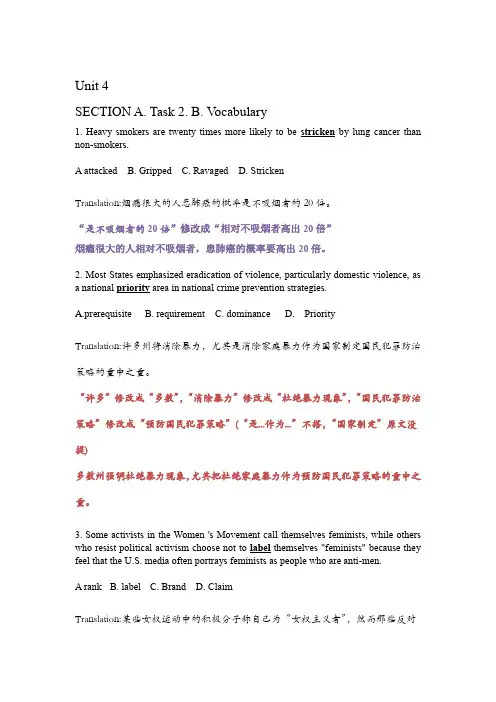
Unit 4SECTION A. Task 2. B. V ocabulary1. Heavy smokers are twenty times more likely to be stricken by lung cancer than non-smokers.A attacked B. Gripped C. Ravaged D. StrickenTranslation:烟瘾很大的人患肺癌的概率是不吸烟者的20倍。
“是不吸烟者的20倍”修改成“相对不吸烟者高出20倍”烟瘾很大的人相对不吸烟者,患肺癌的概率要高出20倍。
2. Most States emphasized eradication of violence, particularly domestic violence, asa national priority area in national crime prevention strategies.A.prerequisiteB. requirementC. dominanceD. PriorityTranslation:许多州将消除暴力,尤其是消除家庭暴力作为国家制定国民犯罪防治策略的重中之重。
“许多”修改成“多数”,“消除暴力”修改成“杜绝暴力现象”,“国民犯罪防治策略”修改成“预防国民犯罪策略”(“是...作为...”不搭,“国家制定”原文没提)多数州强调杜绝暴力现象,尤其把杜绝家庭暴力作为预防国民犯罪策略的重中之重。
3.Some activists in the Women 's Movement call themselves feminists, while others who resist political activism choose not to label themselves "feminists" because they feel that the U.S. media often portrays feminists as people who are anti-men.A rank B. label C. Brand D. ClaimTranslation:某些女权运动中的积极分子称自己为“女权主义者”,然而那些反对政治激进主义的人却不愿这么做,因为他们认为“女权主义者”经常被美国的媒体用来称呼那些“‘女权主义者’经常被美国的媒体用来称呼那些”修改成“美国媒体常把“女权主义者”说成是“反人类”的人”(遵照原文改成了主动态)女权运动中的某些积极分子称自己为“女权主义者”,然而那些反对政治激进主义的人却不愿这么做,因为他们认为美国媒体常把“女权主义者”说成是“反人类”的人。
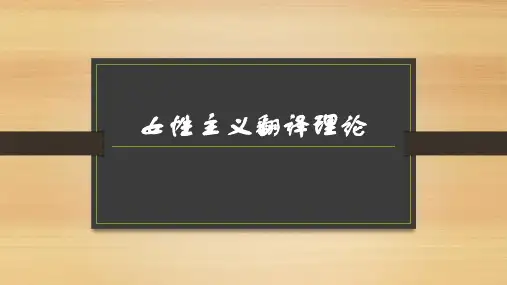
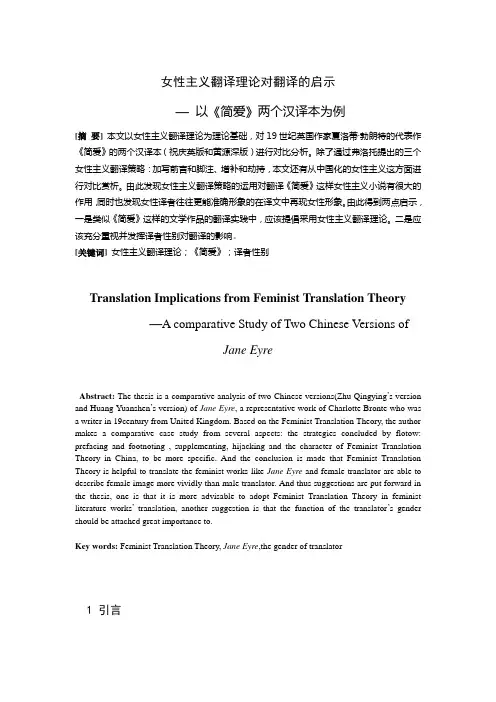
女性主义翻译理论对翻译的启示—以《简爱》两个汉译本为例[摘要] 本文以女性主义翻译理论为理论基础,对19世纪英国作家夏洛蒂〃勃朗特的代表作《简爱》的两个汉译本(祝庆英版和黄源深版)进行对比分析。
除了通过弗洛托提出的三个女性主义翻译策略:加写前言和脚注、增补和劫持,本文还有从中国化的女性主义这方面进行对比赏析。
由此发现女性主义翻译策略的运用对翻译《简爱》这样女性主义小说有很大的作用,同时也发现女性译者往往更能准确形象的在译文中再现女性形象。
由此得到两点启示,一是类似《简爱》这样的文学作品的翻译实践中,应该提倡采用女性主义翻译理论。
二是应该充分重视并发挥译者性别对翻译的影响。
[关键词] 女性主义翻译理论;《简爱》;译者性别Translation Implications from Feminist Translation Theory—A comparative Study of Two Chinese Versions ofJane EyreAbstract: The thesis is a comparative analysis of two Chinese versions(Zhu Qingying’s version and Huang Yuanshen’s version) of Jane Eyre, a representative work of Charlotte Bronte who was a writer in 19century from United Kingdom. Based on the Feminist Translation Theory, the author makes a comparative case study from several aspects: the strategies concluded by flotow: prefacing and footnoting , supplementing, hijacking and the character of Feminist Translation Theory in China, to be more specific. And the conclusion is made that Feminist Translation Theory is helpful to translate the feminist works like Jane Eyre and female translator are able to describe female image more vividly than male translator. And thus suggestions are put forward in the thesis, one is that it is more advisable to adopt Feminist Translation Theory in feminist literature works’translation, another suggestion is that the function of the translator’s gender should be attached great importance to.Key words: Feminist Translation Theory, Jane Eyre,the gender of translator1 引言自从20世纪50年代,翻译研究出现文化转向的萌芽,传统的“对等”翻译观念和思想逐渐受到质疑,人们开始对翻译进行更深层次的思考和探索,开始质疑“对等”是否真是翻译的前提和翻译的目标(Bassnett, Susan and Andre Lefevere,1990:6)。
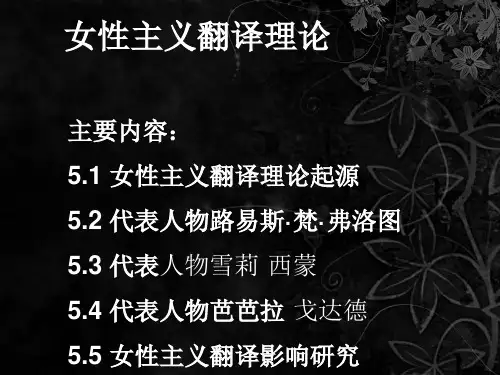
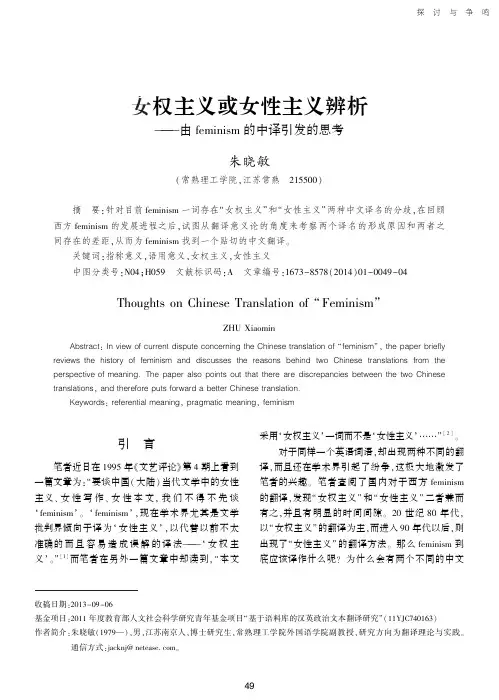
探 讨 与 争 鸣女权主义或女性主义辨析由feminism 的中译引发的思考朱晓敏(常熟理工学院,江苏常熟 215500) 摘 要:针对目前feminism 一词存在 女权主义”和 女性主义”两种中文译名的分歧,在回顾西方feminism 的发展进程之后,试图从翻译意义论的角度来考察两个译名的形成原因和两者之间存在的差距,从而为feminism 找到一个贴切的中文翻译㊂关键词:指称意义,语用意义,女权主义,女性主义中图分类号:N04;H059 文献标识码:A 文章编号:1673-8578(2014)01-0049-04Thoughts on Chinese Translation of Feminism”ZHU XiaominAbstract :In view of current dispute concerning the Chinese translation of feminism ”,the paper briefly reviews the history of feminism and discusses the reasons behind two Chinese translations from the perspective of meaning.The paper also points out that there are discrepancies between the two Chinese translations ,and therefore puts forward a better Chinese translation.Keywords :referential meaning ,pragmatic meaning ,feminism收稿日期:2013-09-06基金项目:2011年度教育部人文社会科学研究青年基金项目 基于语料库的汉英政治文本翻译研究”(11YJC740163)作者简介:朱晓敏(1979 ),男,江苏南京人,博士研究生,常熟理工学院外国语学院副教授,研究方向为翻译理论与实践㊂通信方式:jacknj@㊂引 言笔者近日在1995年‘文艺评论“第4期上看到一篇文章为: 要谈中国(大陆)当代文学中的女性主义㊁女性写作㊁女性本文,我们不得不先谈 feminism’㊂ feminism’,现在学术界尤其是文学批判界倾向于译为 女性主义’,以代替以前不太准确的而且容易造成误解的译法 女权主义’㊂”[1]而笔者在另外一篇文章中却读到, 本文采用 女权主义’一词而不是 女性主义’ ”[2]㊂对于同样一个英语词语,却出现两种不同的翻译,而且还在学术界引起了纷争,这极大地激发了笔者的兴趣㊂笔者查阅了国内对于西方feminism 的翻译,发现 女权主义”和 女性主义”二者兼而有之,并且有明显的时间间隙㊂20世纪80年代,以 女权主义”的翻译为主,而进入90年代以后,则出现了 女性主义”的翻译方法㊂那么feminism 到底应该译作什么呢?为什么会有两个不同的中文94中国科技术语/2014年第1期翻译呢?带着这一系列的问题,笔者试图从翻译学的角度对feminism及其中文翻译进行考证㊂具体来说,就是从翻译意义论的角度来衡量在意义层面上, feminism应译为 女权主义”还是 女性主义”,哪个中译名更加贴近原意㊂奈达的 translation means translating meaning (翻译,即译意)”说,从根本上明确了翻译的任务或使命所在㊂落实到具体的文本翻译,对于词㊁句子㊁篇章的意义的理解㊁阐释与再生产,贯穿翻译的整个过程之中,如果不能对所译对象的意义有充分的㊁准确的理解,那么译本必定是含混晦涩的,也就失去了翻译作为跨文化交流桥梁的作用了㊂在对于文本意义的理解上,我们不妨借用柯平先生在‘英汉与汉英翻译教程“一书中的观点: 在表意的层面上,语言符号的意义可以从两个角度去认识,即指称意义(referential meaning)和语用意义(pragmatic meaning)㊂指称意义是语言符号和它所描绘或叙述的主观世界或客观世界的实体和事件之间的关系,它主要同交际主题相关㊂语用意义则是发讯人与收讯人在语言使用中与语言符号所发生的关系,包括表征意义㊁表达意义㊁社交意义㊁祈使意义和联想意义㊂”[3]下面笔者将从指称意义和语用意义两个层面来考察feminism㊂一 指称意义角度的考察作为翻译者,我们在碰到一个自己不太确定的新词的指称意义时,首先想到的是求助于比较权威的词典或百科全书㊂那么现有的权威词典或百科全书对于feminism是如何定义的呢?在2000年版的Webster’s Third New International Dictionary里,对于feminism的定义如下(粗体部分为笔者所加,以下同):Feminism:the theory of the political,economical,and social equality of the sexes;organized activity on behalf of women’s rights and interests;specifically,the19th and20th century movement seeking to remove restrictions that discriminate against women.从粗体部分来看,词典编撰者在定义feminism一词时,十分注重该词在权利(right)方面的要求,也就是说feminism是西方女性为了追求与男性同等权利而发起的维权运动,是针对占统治地位男权中心主义发起的挑战,是父权制中女人为争得权利的一种平均主义的呼吁和追求㊂因此,feminism翻译为 女权主义”是符合原词指称意义的正确的翻译㊂二 语用意义角度的考察英国翻译理论家纽马克(Newmark)曾指出: 译者在翻译一个文本时,必须确定指称性符号在其上下文中的确切所指对象㊂换言之,他或她应该后退一步,大致弄清楚真实世界里所发生的事情,而不应该只是使自己相信:刚刚译完的一个句子在语言学上是有意义的㊂”[4]纽马克先生这句话的意思是:译者要译的应是原文语言符号的语用意义,而不是它的指称意义,要注重语言符号与它外部世界事物紧密联系的特性㊂鉴于此,我们在译介feminism时,就要追溯西方社会的妇女解放运动的历史,把握该词出现和使用的背景,即语用背景㊂发轫于西方妇女运动的feminism,历经百余年,其发展经历了三个阶段:第一阶段发生于19世纪中叶,这一阶段以追求妇女的社会权利为目标,及至20世纪20年代,这场运动以西方社会关于妇女财产权㊁选举权等法案的通过而胜利告终㊂第二阶段发生于20世纪60年代,与美国黑人解放运动㊁学生运动及法国1968年五月风暴激进思潮紧密相联,这一阶段以女性意识的觉醒及对男权中心主义的批判为特点㊂第二阶段feminism的理论标志是1970年出版的凯特㊃米利特(Kate Millett)‘性政治“一书㊂在该书中,米利特从政治的角度来看待两性关系,认为历史上男性和女性的关系一直是一种权力支配的关系,它是人类文化中最根深蒂固的压迫关系㊂第三阶段则产生于20世纪70 80年代,在后现代主义㊁后殖民主义以及环保生态主义等思潮的影响下而出现了feminism的各流派,其中包括后现代feminism㊁生态feminism㊁第三世界feminism等㊂05探 讨 与 争 鸣通过对feminism的简单历史回顾,我们不难发现,西方feminism在20世纪60年代以前是以争取平等的社会权利为旗帜,如财产权㊁选举权等,以非暴力抵抗为途径,从而实现作为妇女所应有的权利,这一时期的斗争基本上都取得了胜利㊂ 权利”是feminism在这一时期追求的核心,因此,翻译为 女权主义”是符合它当时的语用意义的㊂而60年代以后的斗争则是以女性性别意识的觉醒为显著特征㊂因此,60年代以后的feminism翻译为 女性主义”,是符合客观世界所发生的事件的,是对该词语用意义的准确把握㊂三 feminism”究竟该译作什么大连大学性别研究中心主持人李小江女士的一席话,部分道出了feminism的翻译出现分歧的原因: 译成中文,早先说是 女权主义’,然后是 女性主义’ 我注意到,但凡说到西方,总说它是女权主义;但只要涉及这片土地, feminism’便成了女性主义,温和了许多,文化了许多 ”[5]很显然,李小江女士所说的 这片土地”是导致出现两种翻译的原因㊂ 这片土地”意指中国,那为什么一到 这片土地”上,激进的 女权主义”就变成温和的 女性主义”了呢?在中国这片土地上, 如果我们仔细考察一下中国历史,就会发现,虽然在中国大地上,人们对 时代不同了,男女都一样’这样的说法耳熟能详,这片 男女都一样’的国土上却从没有出现过真正意义上的女权运动[6]㊂”在从没有出现过女权运动的中国,是否就没有妇女解放运动呢?答案是:中国不但有妇女解放运动,而且中国的妇女解放运动有许多西方妇女解放运动所鲜见的中国特色之处㊂从20世纪初开始一直到新中国成立,又延伸到今天的改革,妇女解放乃至妇女问题始终在政府视野范围之内,也在政府决策和实践范围以内㊂基于以上所做的调查和考证,可以归纳出feminism一词产生两种翻译的原因㊂原因之一,feminism属于西方意识形态范畴,在引进介绍之时,中国正处于一个被不精确地称之为 文化热”的启蒙主义批评的复苏和高潮之中,对于西方理论的译介,注重其 新” 奇”和 他性”㊂在这片从没有过女权运动的土地上,feminism理论所具有的巨大诱惑性和启蒙性,是许多译者热衷于翻译介绍的原因所在㊂20世纪80年代中后期到90年代中期,国内理论界开始全面梳理80年代 文化热”,总结得失,结果发现女权主义是 以资产阶级自由㊁平等思想为基础,要求结束妇女从属地位,主张男女两性平等,是资产阶级妇女运动的主要理论基础”[7]㊂既然是 资产阶级妇女运动的主要理论基础”,那么 女权主义”的译法就有误导国人之嫌,作为理论而言,太过于激进了,于是温和的㊁阶级性淡化的 女性主义”翻译出现了㊂这就是文化适应性问题,文化适应性是价值观论的重要组成部分,是指: 文化信息的表现应该适应目的语的文化现实和发展之所需 ,从意识形态和观念的价值标准来看,任何目的语文化都倾向于接受和吸收与自己 恰恰调和’(梁启超,1904)的表现形式的 ”[8]原因之二,从两种翻译出现的时间上来看,20世纪80年代出现 女权主义”的翻译是因为在西方妇女解放运动进入第二阶段后,中国正处于文化大革命后的思想迷惘混沌时期,在翻译作品的选择上没有跟上时代的步伐,虽然抓住了feminism的指称意义,却忽视了西方feminism在客观世界里所呈现出的新特点㊂到了90年代,随着大批妇女解放运动理论成果的译介,尤其是凯特㊃米利特‘性政治“一书的翻译介绍,国内学术界把握到feminism 新的发展动向,因而出现了 女性主义”的翻译㊂四 结 语不论是 女权主义”还是 女性主义”都不能准确概括feminism的全部历史含义和新的发展动向㊂鉴于此,笔者建议使用 女权/女性主义”的译法㊂使用这样的翻译,既可以避免 女权主义”和 女性主义”翻译信息不足的缺点,也可以展现西方妇女解放运动从追求男女平等权利到解构和颠覆菲勒斯㊃逻各斯中心主义,消解两性二元对立的历史发展进程㊂(下转第57页) 15溯 源(C)OOH,不但使脂肪酸与脂环酸㊁芳香酸命名中 酸”字含义保持一致,也与无机酸命名中 酸”的含义是统一的㊂在‘化学命名原则“(1932)中,将C6H5COOH的名称确立为 苯甲酸”而不是 苯酸”,反映了术语命名的准确性㊂注 释①关于羧基命名法的论述,可参见:Patterson A.Definitive Report of the Commission on the Reform of the Nomenclature of Organic Chemistry Translation with Comments[J].J. Am.Chem.Soc.,1933,55(10):3916.②笔者注:此处当为C n H2n-4O4的误写㊂③20世纪初,不同的中文无机物命名方案在命名酸时,采用的定性词头有所不同㊂可参见:何涓.清末民初(1901 1932)无机物中文命名演变[J].科技术语研究,2006,8(2):53-57.参考文献[1]虞和钦.有机化学命名草[M].东京:同文印刷舍, 1908:50-51.[2]马君武.实用有机化学教科书[M].上海:商务印书馆,1919.[3]中国化学会欧洲支会.中国化学会欧洲支会戊申年报告[R].1908.[4]梁国常.有机化学命名刍议[J].科学,1920(10):1000.[5]梁国常.有机化学命名刍议(续)[J].科学,1920(11):1106.[6]Bernthsen A.A Textbook of Organic Chemistry[M]. Edited and revised by Sudborough J.New York:D.Van Nostrand Company,1912:40.[7]杜亚泉.有机化学命名之讨论[J].学艺,1920(8):9.[8]科学名词审查会.有机化合物命名草案[M].1920:8 -9.[9]科学名词审查会.科学名词审查会所审定之有机化学名词草案[J].科学,1922(5):469-503.[10]吴承洛.有机化学译名法[J].北大化学会年刊,1926(1):26-138.[11]屠阝恂立.有机化学名词之商榷(续)[J].科学,1931(5):817-827.[12]屠阝恂立.有机化学名词之商榷(续)[J].科学,1931(6):997-1008.[13]中国化学研究会.有机化学译名草案[J].学艺,1922(9):1.[14]杜亚泉,郑贞文.有机化学[M].上海:商务印书馆,1924.[15]曾昭抡.日内瓦命名法原案[J].科学,1934(8):1132.[16]国立编译馆.化学命名原则[M].南京:国立编译馆,1933:iv.(上接第51页) 由此可见,在翻译介绍西方理论时,理论术语的翻译不可望词生义,即使是非常微小的变动,如从 女权主义”的 权”到 女性主义”的 性”,都会产生完全不同的效果㊂在翻译时,除了要能准确地把握词语的指称意思,更重要的是,还要理解词语在客观世界里的语用背景㊂词语更新的速度总是慢于客观物质世界的发展,而翻译介绍别国的理论和作品时,又存在着时间上的差距,因此,译者在翻译的时候,一定要致力于缩短这个时间差㊂参考文献[1]陈虹.中国当代文学:女性主义㊃女性写作㊃女性本文[J].文艺评论,1995(4):42-47.[2]杨俊蕾.从权利㊁性别到整体的人 20世纪欧美女权主义文论述要[J].外国文学,2002(5):44-51. [3]柯平.英汉与汉英翻译教程[M].北京:北京大学出版社,1993:21.[4]纽马克.翻译教程[M].上海:上海外语教育出版社,2001:23.[5]李小江,等.女性㊃主义[M].南京:江苏人民出版社,2000:前言.[6]张岩冰.女权主义文论[M].济南:山东教育出版社,1998:190.[7]中国妇女大百科全书[M].长春:北方妇女儿童出版社,1995:80.[8]刘宓庆.文化翻译论纲[M].湖北:湖北教育出版社,1999:259.75。
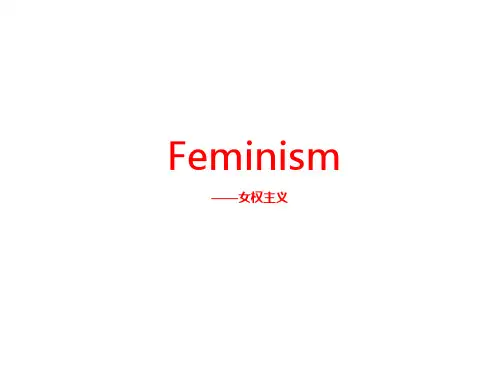
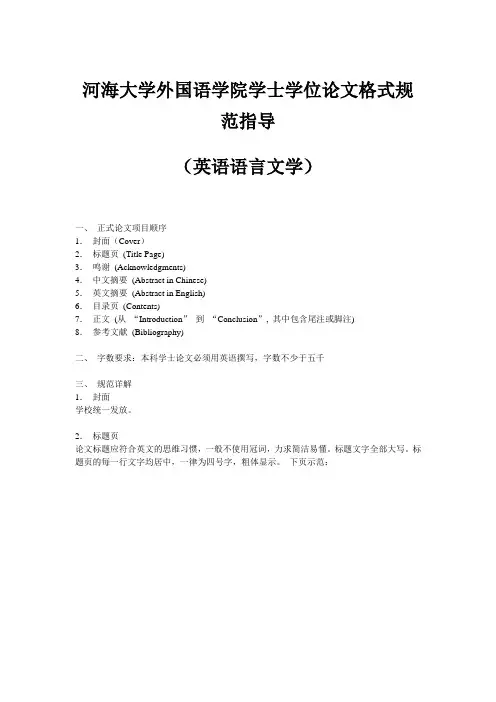
河海大学外国语学院学士学位论文格式规范指导(英语语言文学)一、正式论文项目顺序1.封面(Cover)2.标题页(Title Page)3.鸣谢(Acknowledgments)4.中文摘要(Abstract in Chinese)5.英文摘要(Abstract in English)6.目录页(Contents)7.正文(从“Introduction”到“Conclusion”, 其中包含尾注或脚注)8.参考文献(Bibliography)二、字数要求:本科学士论文必须用英语撰写,字数不少于五千三、规范详解1.封面学校统一发放。
2.标题页论文标题应符合英文的思维习惯,一般不使用冠词,力求简洁易懂。
标题文字全部大写。
标题页的每一行文字均居中,一律为四号字,粗体显示。
下页示范:Hohai UniversityGENDER IN FEMINIST TRANSLATION STUDIESA ThesisSubmitted to the College of Foreign Language and Culture Studies In Partial Fulfillment of Requirements forDegree of Bachelor of ArtsByZhou ChutongUnder Supervision of Associate Professor Li XiaolongJune 20153.鸣谢行文语气要严肃敬重,内容须紧扣论文和学术的前后过程,切忌离题,避免主客倒置。
“Acknowledgments”必须为复数形式。
鸣谢页不须标注页码。
例:AcknowledgmentsAt the point of finishing this paper, I’d like to express my sincere thanks to all those who have lent me hands in the course of my writing this paper...4.摘要4.1 摘要必须概括论文的主要内容,突出论文的创新点。
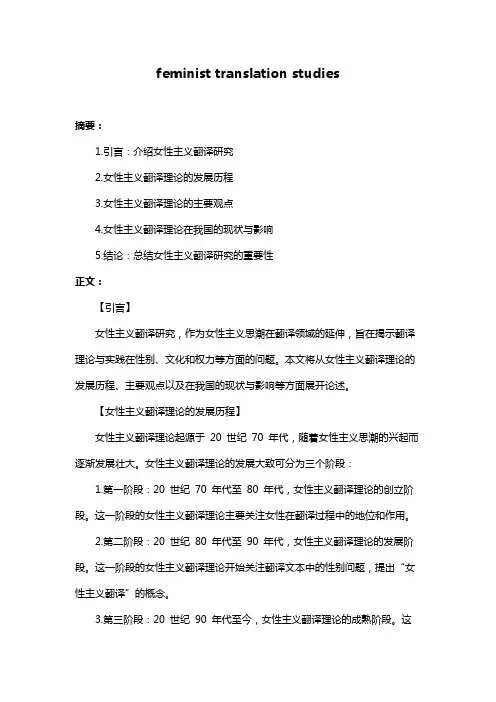
feminist translation studies摘要:1.引言:介绍女性主义翻译研究2.女性主义翻译理论的发展历程3.女性主义翻译理论的主要观点4.女性主义翻译理论在我国的现状与影响5.结论:总结女性主义翻译研究的重要性正文:【引言】女性主义翻译研究,作为女性主义思潮在翻译领域的延伸,旨在揭示翻译理论与实践在性别、文化和权力等方面的问题。
本文将从女性主义翻译理论的发展历程、主要观点以及在我国的现状与影响等方面展开论述。
【女性主义翻译理论的发展历程】女性主义翻译理论起源于20 世纪70 年代,随着女性主义思潮的兴起而逐渐发展壮大。
女性主义翻译理论的发展大致可分为三个阶段:1.第一阶段:20 世纪70 年代至80 年代,女性主义翻译理论的创立阶段。
这一阶段的女性主义翻译理论主要关注女性在翻译过程中的地位和作用。
2.第二阶段:20 世纪80 年代至90 年代,女性主义翻译理论的发展阶段。
这一阶段的女性主义翻译理论开始关注翻译文本中的性别问题,提出“女性主义翻译”的概念。
3.第三阶段:20 世纪90 年代至今,女性主义翻译理论的成熟阶段。
这一阶段的女性主义翻译理论逐渐形成了一套完整的理论体系,并开始关注女性在翻译实践中的挑战和机遇。
【女性主义翻译理论的主要观点】女性主义翻译理论的主要观点包括:1.性别意识:认为翻译过程中的性别问题应引起重视,翻译作品应关注女性在社会、文化、历史等方面的地位和作用。
2.文化差异:强调翻译应尊重原文的文化背景,充分考虑文化差异,避免将一种文化观念强加于另一种文化。
3.权力关系:认为翻译是一种权力关系,女性在翻译过程中可能面临各种权力压迫,因此需要关注女性在翻译实践中的地位和权力。
【女性主义翻译理论在我国的现状与影响】自20 世纪90 年代以来,女性主义翻译理论在我国逐渐受到关注。
目前,我国女性主义翻译研究已取得了一定的成果,并为我国的翻译实践和理论研究提供了新的视角和思路。
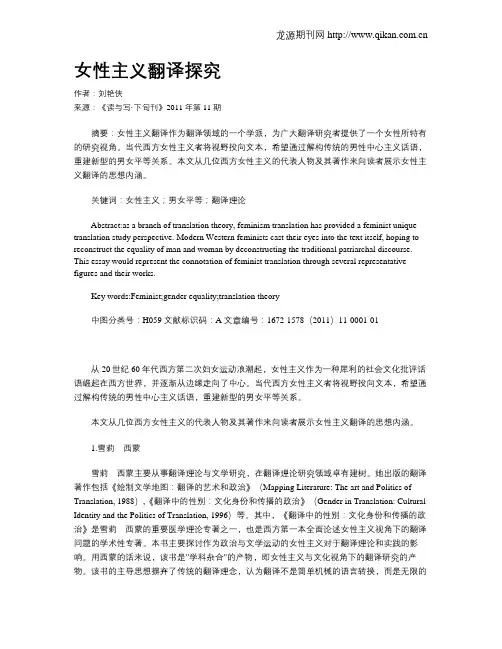
女性主义翻译探究作者:刘艳侠来源:《读与写·下旬刊》2011年第11期摘要:女性主义翻译作为翻译领域的一个学派,为广大翻译研究者提供了一个女性所特有的研究视角。
当代西方女性主义者将视野投向文本,希望通过解构传统的男性中心主义话语,重建新型的男女平等关系。
本文从几位西方女性主义的代表人物及其著作来向读者展示女性主义翻译的思想内涵。
关键词:女性主义;男女平等;翻译理论Abstract:as a branch of translation theory, feminism translation has provided a feminist unique translation study perspective. Modern Western feminists cast their eyes into the text itself, hoping to reconstruct the equality of man and woman by deconstructing the traditional patriarchal discourse. This essay would represent the connotation of feminist translation through several representativeKey words:Feminist;gender equality;translation theory中图分类号:H059 文献标识码:A 文章编号:1672-1578(2011)11-0001-01从20世纪60年代西方第二次妇女运动浪潮起,女性主义作为一种犀利的社会文化批评话语崛起在西方世界,并逐渐从边缘走向了中心。
当代西方女性主义者将视野投向文本,希望通过解构传统的男性中心主义话语,重建新型的男女平等关系。
本文从几位西方女性主义的代表人物及其著作来向读者展示女性主义翻译的思想内涵。
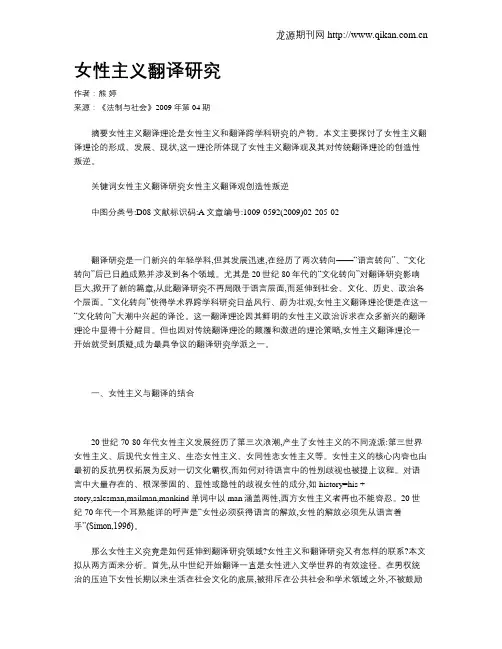
女性主义翻译研究作者:熊婷来源:《法制与社会》2009年第04期摘要女性主义翻译理论是女性主义和翻译跨学科研究的产物。
本文主要探讨了女性主义翻译理论的形成、发展、现状,这一理论所体现了女性主义翻译观及其对传统翻译理论的创造性叛逆。
关键词女性主义翻译研究女性主义翻译观创造性叛逆中图分类号:D08文献标识码:A文章编号:1009-0592(2009)02-205-02翻译研究是一门新兴的年轻学科,但其发展迅速,在经历了两次转向——“语言转向”、“文化转向”后已日趋成熟并涉及到各个领域。
尤其是20世纪80年代的“文化转向”对翻译研究影响巨大,掀开了新的篇章,从此翻译研究不再局限于语言层面,而延伸到社会、文化、历史、政治各个层面。
“文化转向”使得学术界跨学科研究日益风行、蔚为壮观,女性主义翻译理论便是在这一“文化转向”大潮中兴起的译论。
这一翻译理论因其鲜明的女性主义政治诉求在众多新兴的翻译理论中显得十分醒目。
但也因对传统翻译理论的颠覆和激进的理论策略,女性主义翻译理论一开始就受到质疑,成为最具争议的翻译研究学派之一。
一、女性主义与翻译的结合20世纪70-80年代女性主义发展经历了第三次浪潮,产生了女性主义的不同流派:第三世界女性主义、后现代女性主义、生态女性主义、女同性恋女性主义等。
女性主义的核心内容也由最初的反抗男权拓展为反对一切文化霸权,而如何对待语言中的性别歧视也被提上议程。
对语言中大量存在的、根深蒂固的、显性或隐性的歧视女性的成分,如history=his +story,salesman,mailman,mankind单词中以man涵盖两性,西方女性主义者再也不能容忍。
20世纪70年代一个耳熟能详的呼声是“女性必须获得语言的解放,女性的解放必须先从语言着手”(Simon,1996)。
那么女性主义究竟是如何延伸到翻译研究领域?女性主义和翻译研究又有怎样的联系?本文拟从两方面来分析。
首先,从中世纪开始翻译一直是女性进入文学世界的有效途径。
女权(Feminism)又称女权主义,女性主义。
是指一个主要以女性经验为来源与动机的社会理论与社会运动。
在对社会关系进行批判之外,许多女性主义的支持者也着重于性别不平等的分析以及推动妇女的权利、利益与议题。
女性主义理论的目的在于了解不平等的本质以及着重在性政治、权力关系与性意识(sexuality)之上。
女性主义政治行动则挑战诸如生育权、堕胎权、教育权、家庭暴力、产假(maternity leave)、薪资平等、投票权、性骚扰、性别歧视与性暴力等等的议题。
女性主义探究的主题则包括歧视、刻板印象、物化(尤其是关于性的物化)、身体、家务分配、压迫与父权。
女性主义的观念基础是认为,现时的社会建立于一个男性被给予了比女性更多特权的父权体系之上。
现代女性主义理论主要、但并非完全地出自于西方的中产阶级学术界。
不过,女性主义运动是一个跨越阶级与种族界线的社会运动。
每个文化下面的女性主义运动各有其独特性,并且会针对该社会的女性来提出议题,比如苏丹的性器割除(genital mutilation,请见女性割礼)或北美的玻璃天花板效应(glass ceiling)。
而如强奸、乱伦与母职则是普世性的议题。
历史早期的女权主义者与最初的女权运动通常被称为“第一波女性主义”(thefirst-wave),而1960年之后的女权主义被称为“第二波女性主义”(the second-wave)。
也有所谓的第三波女性主义(the third-wave),但是女性主义者之间对于其存在必要性、贡献与概念意见不一。
这三个“波”之所以如此称呼,是因为就像海浪般,一个接一个永不间断,后来者运用了前行者的贡献与资源。
现代女权主义有个非常重要的支援因素就是人类学家玛格丽特·米德(Margaret Mead)出版的《三个原始部落的性别与气质》(Sex and Temperament in Three Primitive Societies,1935年)一书。
第20卷第2期2007年6月北京航空航天大学学报(社会科学版)Journal of Beijing University of Aeronau tics and As tronautics(Social Sciences Edi tion)Vol.20 No.2June,2007女性主义翻译观的启示与反思杨朝燕,刘延秀(华中农业大学外语系,湖北武汉430070)摘 要:西方女性主义与翻译研究的结合在20世纪后30年给传统翻译理论与实践观点带来了强烈的冲击,成为译学界的一股新生力量。
文章着重探究了女性主义翻译观对翻译研究与实践及中国文学翻译的启示,并对其局限性和发展前景进行了反思。
关键词:女性主义翻译观;传统翻译理论;启示;反思中图分类号:H31519 文献标识码:A 文章编号:1008-2204(2007)02-0061-05收稿日期:2005-09-26作者简介:杨朝燕(1970-),女,湖北天门人,副教授,硕士,研究方向为应用语言学与翻译.Reflections on Feminist Translation TheoryY ANG Zhao -yan,LIU Y an -xiu(Department of Foreign Languages,Huazhong Agricul tural Universi ty,Wuhan 430070,China)Abstract:The combination of feminism and translation had a strong impact on traditi onal translation theories and prac -tice in the last 30years of the last century,thus becoming a new force in the translation circle.This paper mainly ex -plores how feminis t translation theory throws light on traditional translation studies as well as Chinese li terary transla -tion.Meanwhile,the theory .s limitations and future development are discussed.Key words:feminis t translation theory;traditional translati on theories;inspirations;reflections西方女性主义翻译理论是20世纪70年代翻译研究/文化转向0的最新发展与女性主义运动相结合的产物。
一、在“对翻译探讨流派的分类考察”(朱健平,2004)一文中,作者将翻译探讨按探讨层次分为語文学派、語言学派、文化学派和哲学学派。
文化学派,目的語文本其实目的語文化既定事实。
而女性主义的翻译对策目的語的翻译方式,,旨在以文化学派为指导,以侧重目的語的女性主义翻译者在翻译中发挥主观能动性“重写”是当时的文化背景与社会潮流的。
二、文化学派及女性主义特点1.文化学派阐述以探讨层次来看,翻译涉及到語言、审美、文化、思维等,,对翻译的探讨也以不同的层次来切入,这样,所切入的层次不同而形成了不同的翻译流派。
但以的情况看来,以标准为的分类似乎还不太统一(朱健平,2004)。
最近翻译界又了文化学派,多对译者、译文和译文读者的探讨。
译文,但是以完全不同的角度来讨论译文的。
将的焦点转移到了译者在目的語文化多元系统中所处的地位所发挥的作用上,更加探讨那些影响目的語文本在目的語文化中发挥作用的因素,并把这些对翻译起约束作用的因素称之为“规范”(norms),翻译是受规范支配的活动(Toury, 2001:56)。
2.女性主义的特点女性主义(feminism),亦称女权主义。
女权主义一词是由日文转译成中文的称谓,西方称为女性主义。
最开始的女性主义者,男女应同工同酬,享有同等的机会和权利,但当代西方妇女运动已经超越了男女平等的阶段,转向强调女性的意识,并用女性的意识重新审视整个社会文化及历史传统。
20世纪80年代后,西方妇女运动拓展为反对文化霸权(是受后殖民主义论述的影响。
在翻译论述,她们也持相同的,并将来自论述的影响带进了对翻译的探讨和思索中,形成了颇具个性的女性主义翻译观。
女性主义观滥觞于北美,波及全球:代表人物有L.Flotow、S.Simon、G.Spivak等。
显然,在当时的文化背景下,女性主义译者在翻译中发挥的主观能动性,使得女性主义翻译对策与一般作用小学数学教学论文上的传统翻译论述自然也不同。
三、女性主义翻译对策与传统翻译论述不同传统翻译论述的探讨兴趣作者、原文和翻译,而当代翻译探讨则已将兴趣转移到了译者、译文和译文读者的身上,一般将前者称为重源語文本的翻译探讨(Source Text?鄄oriented Translation Studies),将后者称为重目的語文本的翻译探讨(Target Text?鄄oriented Tanslation Studies)。
女性主义性别意识在翻译中的体现———枟一间自己的房间枠译本解读◆高雅(江苏师范大学外国语学院)女性主义翻译理论起源于加拿大女性主义者的翻译实践,它为翻译研究做出了巨大的贡献。
它以为女性和译者争取地位为己任,不仅凸显了译者主体性,而且通过翻译实践唤醒了人们的性别意识。
通过对女性主义作家弗吉尼亚·伍尔芙枟一间自己的房间枠的译本分析发现:女性译者虽然没有刻意地在译著过程中进行女性主义翻译策略的干预,但是,在她们的译本中,或多或少地可以找到一些男性译本中所没有的、对女性意识、女性尊严、与女性真我本色的独特的艺术表现,尤其是在有关男女对立场景的描写中。
女性主义性别意识翻译20世纪80年代以后,形式主义、后结构主义、解构主义、后现代主义等西方理论的出现,促使了女性主义理论的崛起。
女性主义翻译理论是将文化政治引入到文学的研究中而产生的:女性为了能像男人一样,用自己的语言来描述和反映自己的内心世界、社会经验和个人体验,来表达其特殊性和差异性,让女性拥有话语权,使女性获得与男人现实和精神上的平等地位,认为翻译是介入语言的最好的途径(张舍如,2009)。
女性译者在翻译的过程中,或多或少透露出的男性译本中所没有的对女性意识的维护和展现,是本文探讨的重点。
一、女性主义女性主义在西方的代表人物主要有巴巴拉戈达尔德,雪莉.西蒙,路易斯.梵.伏洛图和洛特比涅尔.哈伍德等。
代表作有西蒙的枟翻译的性别:文化等同和传递政治枠,伏洛图的枟翻译与性别:女性主义时代的翻译枠。
弗洛图总结女性主义介入文本的方式有增补、前言和脚注和劫持。
西蒙的观点则认为女性主义翻译应致力凸显译者主体性、解构原文、强调作者和译者、原文和译文的平等关系以及强调翻译是政治行为,翻译是创造性“重写”。
在中国,廖七一首先将女性主义与翻译结合在一起。
随着西方著作的引进,女性主义翻译研究在中国正式开启。
代表人物有穆雷、徐来、刘军平、刘亚儒等,并且逐渐开始在女性主义框架下探讨译者的主体性问题。
女性主义翻译观下的译者主体性:The identity and status of translatorareundervalued in traditional translation studies especiallythe identity of feminist translation theory. The feministtranslation theory is a school of translationtheoryprevalent in Western countries ,which put emphasis on the subjectivity of female translator in 1990s. This thesis isgoing to introduce the development of subjectivity brieflyand discuss the English version of Ashima intheperspective of subjectivity in order to reveal its feminist consciousness.i=r由于19 世纪80 年代翻译出现新的研究方向,加之女性主义运动在当时开展地如火如荼,二者相结合就产生了女性主义翻译理论。
女性主义翻译在十九世纪末与二十世纪初的这段时间里提出了性别译者身份的概念,该理论为翻译理论界拓宽了其研究与发展的新领域,展开了一个翻译理论研究的新境界。
作为女性主义翻译理论中最具代表性的学者,雪莉?西蒙认为翻译应该重新界定译作和原作的关系(Simon,1996: 1 )。
为了消除语言上的歧视,女性主义者力求通过翻译这样的文化交流媒介来突破女性身份被边缘化和被忽视的现状。
本文选择《阿诗玛》的英译本作为研究对象,因为其译者是我国著名女性翻译家戴乃迭,她对中国汉译英领域有着不可磨灭的贡献,其译作也充满了女性主义意识。